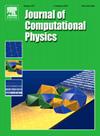A semi-Lagrangian meshfree lattice Boltzmann method for incompressible two-phase flows
IF 3.8
2区 物理与天体物理
Q2 COMPUTER SCIENCE, INTERDISCIPLINARY APPLICATIONS
引用次数: 0
Abstract
A new numerical method, which is based on the coupling between semi-Lagrangian meshfree method and two-phase lattice Boltzmann (LB) model, is developed for incompressible two-phase flows. Two LB equations, one is for solving the Cahn-Hilliard equation for capturing interface and the other is for solving the two-phase Navier-Stokes equations for flow field, are involved. In view of the pure convection property of the LB equations, the semi-Lagrangian meshfree method we proposed before is used to solve them. This is a fully meshfree method that inherits all the distinct advantages of meshfree method and traditional LB method. Firstly, it generalizes the LB method to the meshfree case and breaks through the limitation of uniform mesh. Secondly, it eliminates the coupling of temporal and spatial step sizes and thus is easier to meeting specified accuracy requirements. Thirdly, it gives full play to the advantages of LB model in interface capture and parallel computation. Finally, it can solve two-phase flow problems in complex geometric domains by using non-uniform spatial discretization, and maintain high accuracy and stability. Three benchmark tests show the new method possesses an excellent mass conservation ability on both uniform and non-uniform node arrangements. Subsequently, the method is applied to several two-phase flow problems by using non-uniform meshfree nodes. The results agree very well with the analytical or reference solutions even for the rather extreme simulation cases. The good performance of this method suggests it is a powerful tool for solving two-phase flows.
求助全文
约1分钟内获得全文
求助全文
来源期刊

Journal of Computational Physics
物理-计算机:跨学科应用
CiteScore
7.60
自引率
14.60%
发文量
763
审稿时长
5.8 months
期刊介绍:
Journal of Computational Physics thoroughly treats the computational aspects of physical problems, presenting techniques for the numerical solution of mathematical equations arising in all areas of physics. The journal seeks to emphasize methods that cross disciplinary boundaries.
The Journal of Computational Physics also publishes short notes of 4 pages or less (including figures, tables, and references but excluding title pages). Letters to the Editor commenting on articles already published in this Journal will also be considered. Neither notes nor letters should have an abstract.
 求助内容:
求助内容: 应助结果提醒方式:
应助结果提醒方式:


